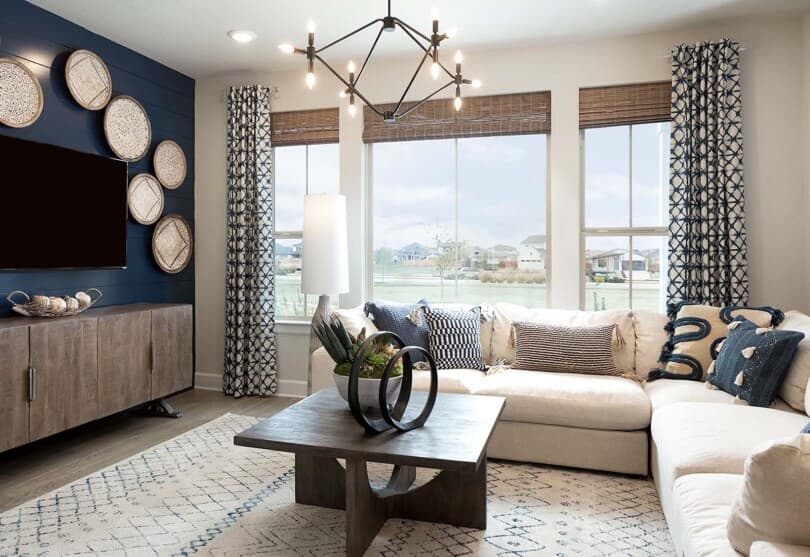Home Safety Checklist
Your home is more than just four walls and a roof – it’s your safe haven, your retreat, and the foundation for your family. It’s where you make fond memories and the backdrop to life’s milestones and important events. It’s more than a place – it’s a feeling.

Beyond organizing our homes and decorating our spaces, caring for our homes also means ensuring it is safe. While the thought of a disaster or emergency happening at home is almost unimaginable, it’s important to be prepared and take proactive measures to prevent anything terrible from happening.
A home safety checklist is a great starting point for assessing your home’s safety measures and creating a family emergency plan. We’ve compiled 15 home safety tips to ensure your home and family stay safe.
1. Smoke detectors
Smoke detectors play a vital role in home safety. They’re designed to detect the presence of smoke and provide an early warning at the first sign of a fire. Fires can occur at any time, including at night when household members are asleep and less likely to notice signs of smoke or fire. Having smoke detectors installed provides peace of mind and time to react.
Install smoke detectors on every level of your home, especially in bedrooms and near the kitchen. Test them regularly and replace batteries at least once a year, if not more frequently. Some recommend changing the batteries twice a year or when you change your clocks for daylight savings time.
2. Carbon monoxide detectors
Carbon monoxide is an odorless, tasteless, and invisible toxic gas. Without a carbon monoxide detector, it is impossible to detect its presence, putting you and your family at risk. A carbon monoxide detector can provide an early warning when levels of the gas rise, allowing you to take immediate action.
Install carbon monoxide detectors near sleeping areas and fuel-burning appliances. Test them regularly and replace batteries as needed.
3. Fire extinguishers
Having a fire extinguisher in the kitchen, garage, and other high-risk areas provides an opportunity to respond immediately to small fires before they escalate. Having them readily available can save lives, protect your home, and minimize the damage caused by fires.
Ensure your fire extinguishers are easily accessible and everyone knows how to use them. Regularly inspect your extinguishers to ensure they are fully charged, have accessible pull pins and safety seals, and are free of any damage.
Educate yourself and your family members on how to operate fire extinguishers effectively by remembering the acronym "PASS": Pull the pin, Aim at the base of the fire, Squeeze the handle, and Sweep side to side. Remember, fire extinguishers are intended for small fires only, and it is crucial to prioritize personal safety and evacuate if the fire becomes unmanageable.

Allen Plan , Urban Courtyard Homes Collection, Easton Park, Austin, Texas
4. Home security system
Installing a home security system or burglar alarm protects against unauthorized entry by burglars or intruders. Often the presence of signs, stickers, or visible cameras can significantly reduce the likelihood of a break-in. Some systems include additional safety features, such as fire detection and authority notification if a break-in is detected.
Determine your specific needs and choose a system that suits your home’s layout and your personal preferences. You can choose which features you need, like surveillance cameras, motion sensors, door/window sensors, and 24/7 professional monitoring.
Regularly maintain and test your system to ensure it functions properly, giving you peace of mind whenever you’re away.
5. Emergency contact list
An emergency contact list is crucial for preparedness and timely response during unexpected situations. It should include important phone numbers, such as emergency services, poison control, family doctors, trusted neighbors, and nearby family members.
Keep your list in a centralized location, like near a phone or on the refrigerator, and update it periodically to ensure the information is accurate.
6. First aid kit
A well-stocked first aid kit is essential for every home as it allows you to provide immediate care and treatment in case of injuries. You can quickly address minor injuries and stabilize injuries until professional medical help arrives.
A basic first aid kit should include:
- Adhesive bandages
- Sterile gauze pads
- Adhesive tape
- Antiseptic solution or wipes
- Scissors
- Tweezers
- Disposable gloves
- Instant cold packs
- Pain relievers
Additional items you may want to include:
- CPR mask
- Elastic bandages
- Thermometer
- Specific medications or supplies relevant to your family’s medical needs
Regularly check your supplies to ensure you haven’t run out, and nothing has expired.

Rundle 24 Plan, Front Garage Collection, Creekstone, Calgary, Alberta
7. Safety gates and window guards
Safety gates and window guards are necessary if your household includes young children or pets. Safety gates prevent access to stairs and rooms with potentially dangerous objects or equipment. They create a safe and secure environment by reducing the risk of falls, injuries, or accidents.
Window guards, on the other hand, are installed on windows, particularly on upper floors, to prevent falls. They act as a protective barrier, preventing children from opening windows or leaning out, and minimize the fall risk.
8. Non-slip mats
Place non-slip mats in bathrooms, showers, kitchens, and near entryways to reduce the risk of slips and falls. They provide a reliable grip on slippery surfaces, such as tiled or hardwood floors, with rubberized backings that enhance traction and grip, even when the floor is wet.
Non-slip mats increase the safety of everyone in your household but are especially helpful for children, elderly individuals, and those with mobility issues.
9. Secure furniture
Unsecured furniture, such as bookcases, cabinets, dressers, or TV stands, can pose a tipping hazard if climbed upon or bumped into. Securely anchoring these items prevents them from shifting or falling during an earthquake and prevents tipping accidents.
- Determine which furniture items are at risk
- Invest in furniture straps or brackets specifically designed for securing furniture to the wall
- Locate the wall studs using a stud finder for a stronger and more secure connection
- Follow the manufacturer’s instructions to install the brackets or straps
- Properly position the furniture against the wall and adjust as necessary to ensure a snug fit
- Test the stability by gently shaking or pushing the furniture
- Adjust as needed

Purcell 24 Plan, Front Garage Conventional Collection, Livingston, Calgary, Alberta
10. Baby proofing measures
Ensuring your home is properly baby proofed is essential to keeping your little one safe as they grow and explore. Young children are naturally curious, and discovery is important to their development, but they must do so in a safe environment.
Baby proofing involves identifying and addressing potential dangers throughout your home and can include the installation of the following:
- Safety gates at the top and bottom of the stairs
- Doorknob covers
- Cabinet and drawer locks
- Electrical outlet covers
- Corner guards
- Furniture straps
- Adequate lighting
You’ll also want to remove obvious hazards and breakable objects. Read our blog post on how to baby proof a house to learn more.
11. Adequate lighting
Well-lit spaces help your home’s functionality and make it safer overall. Sufficient lighting allows for clear visibility, reducing the risk of slips, trips, and falls. Use nightlights in hallways, bathrooms, and near the stairs to safely navigate the area and identify potential hazards.
Adequate lighting on the exterior of your home is also important. Well-lit pathways allow your guests a safe entry and exit, while exterior home lights eliminate dark areas for intruders to hide or attempt entry.
12. Safe storage for hazardous materials
Hazardous materials include cleaning products, pesticides, paints, solvents, and fuels that need to be handled and stored properly. Not only does proper storage prevent accidental exposure, but it also reduces the risk of chemical reactions or leaks.
To store common household hazardous materials safely, follow these guidelines:
- Keep them in their original containers with intact labels to ensure proper identification
- Store them in a cool, dry, and well-ventilated area, away from direct sunlight or heat sources
- Use locked cabinets or high shelves out of reach of children and pets
- Separate incompatible materials to avoid potential reactions
- Keep hazardous materials away from food, beverages, or medications to prevent contamination

Midhurst Valley Community, Midhurst, Ontario
13. Proper electrical safety
Start by visually inspecting electrical cords, outlets, and switches. Look for signs of wear, fraying, or damage, and replace them if necessary. Avoid overloading outlets and switches with multiple plugs; use surge protectors when necessary. Test ground fault circuit interrupters (GFCIs) regularly by pressing the test button to ensure it trips and resets correctly. Check for proper grounding of electrical appliances and outlets.
It is also recommended to have a qualified electrician conduct periodic inspections to identify any potential hazards or issues. If you’ll be performing any electrical work, always turn off the power at the breaker panel, and use appropriate safety measures, such as wearing insulated gloves and using insulated tools.
14. Fire safety measures
Start by installing smoke detectors on every level of your home and in each sleeping area. Test them regularly and replace the batteries at least once a year. Keep fire extinguishers in easily accessible locations, such as the garage and kitchen, and ensure everyone in your household knows how to use them.
Implement fire-safe practices, such as keeping flammable materials away from heat sources, never leaving any fire unattended, and properly extinguishing candles.
Create a family fire plan by:
- Discussing escape routes and meeting points in case of a fire
- Regularly practicing fire drills to ensure everyone knows what to do in case of emergency
- Teaching children to crawl low under smoke and to feel doors for heat before opening them
- Ensuring everyone knows to call emergency services
15. Home maintenance
Being proactive is the best approach to home safety. Regular home maintenance can prevent accidents, reduce hazards, and keep everything secure.
Regular maintenance should include:
- Inspecting and cleaning the gutters to prevent water damage and potential leaks
- Cleaning air filters
- Examining electrical systems, including outlets, switches, and chords
- Testing and replacing batteries in the smoke and carbon monoxide detectors
- Inspecting and maintaining heating and cooling systems, as well as water heaters
- Inspecting and maintaining plumbing systems

Brookfield Residential’s Commitment to Safety
Remember, this list is not exhaustive, and you should customize it based on your specific home and family needs. Regularly review and update your checklist to address any changes or new safety concerns.
At Brookfield Residential, we proudly build our homes to meet the industry’s rigorous standards and ensure your safety by including smoke and carbon monoxide detectors, fire sprinkler systems, GFCIs, fire-resistant construction materials, and more.
Check out the Brookfield Residential blog for design advice, homebuying insights, mortgage tips, and more, including The Benefits of Buying New Construction and The Ultimate Spring Cleaning Checklist. You can also explore where we build and connect with our sales team when you’re ready to learn more. We’ll be expecting you!

